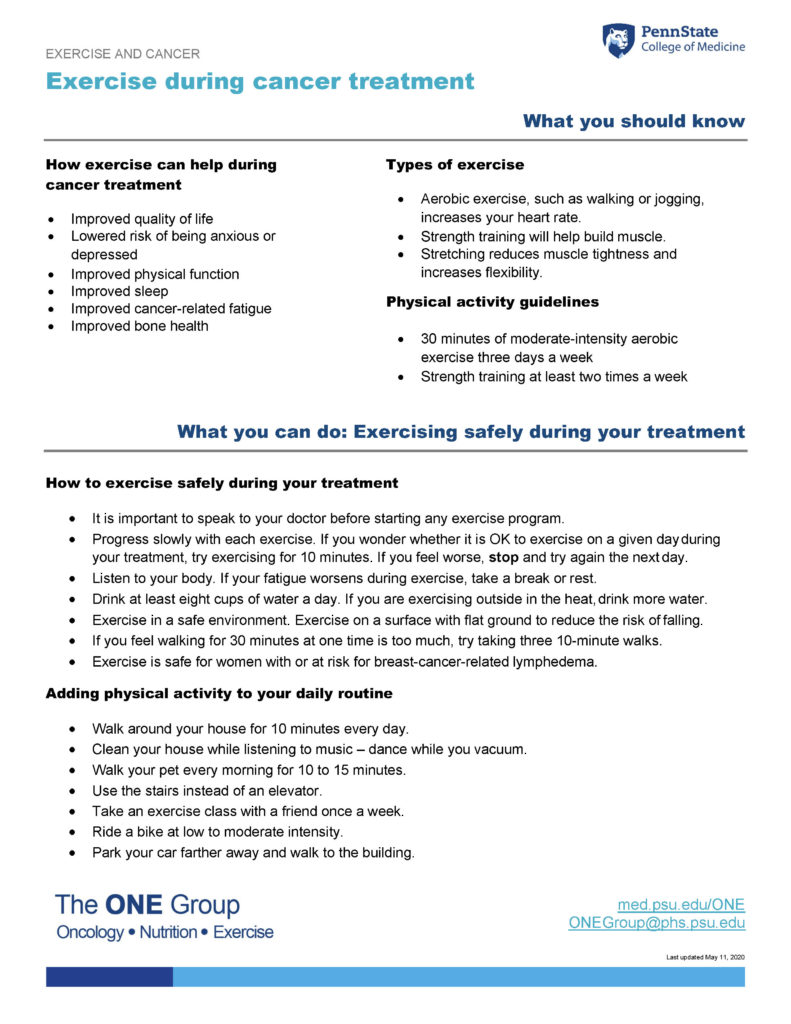Learn about exercise during cancer treatment in this guide from The ONE Group (Oncology – Nutrition – Exercise) at Penn State College of Medicine.
Jump to topic
Search
What you should know
How exercise can help during cancer treatment
- Improved quality of life
- Lowered risk of being anxious or depressed
- Improved physical function
- Improved sleep
- Improved cancer-related fatigue
- Improved bone health
Types of exercise
- Aerobic exercise, such a walking or jogging, increases your heart rate.
- Strength training will help build muscle.
- Stretching reduces muscle tightness and increases flexibility.
Physical activity guidelines
- 30 minutes of moderate-intensity aerobic exercise three days a week
- Strength training at least two times a week
What you can do: Exercising safely during your treatment
How to exercise safely during your treatment
- It is important to speak to your doctor before starting any exercise program.
- Progress slowly with each exercise. If you wonder whether it is OK to exercise on a given day during your treatment, try exercising for 10 minutes. If you feel worse, stop and try again the next day.
- Listen to your body. If your fatigue worsens during exercise, take a break or rest.
- Drink at least eight cups of water a day. If you are exercising outside in the heat, drink more water.
- Exercise in a safe environment. Exercise on a surface with flat ground to reduce the risk of falling.
- If you feel walking for 30 minutes at one time is too much, try taking three 10-minute walks.
- Exercise is safe for women with or at risk for breast-cancer-related lymphedema.
Adding physical activity to your daily routine
- Walk around your house for 10 minutes every day.
- Clean your house while listening to music – dance while you vacuum.
- Walk your pet every morning for 10 to 15 minutes.
- Use the stairs instead of an elevator.
- Take an exercise class with a friend once a week.
- Ride a bike at low to moderate intensity.
- Park your car farther away and walk to the building.
How hard should I work out?
- You can use a scale of 0 to 10 to gauge how hard you are working.
- On a scale of 0 to 10, a rating of zero means you are resting. An intensity rating of 10 means you are working out your body as much as you can.
- Start with working at a slower intensity of 1 to 3.
- After you feel comfortable at a 3, work up to an intensity of 4 to 6. This range is considered “moderate intensity.” At this level, you should be able to speak in sentences without being out of breath.
- If you start to feel the exercise is getting difficult, stop the exercise and decrease the intensity.
- A rating of 9 or 10 means you cannot catch your breath. This is excessive.
Intensity scale at a glance
- 10 – Maximal effort – as hard as you have ever worked
- 9
- 8 – Very hard
- 7 – Moderately hard
- 6
- 5 – Hard
- 4 – Somewhat hard (starting to breathe harder)
- 3 – Moderate
- 2 – Somewhat easy – like walking around your home
- 1 – Very easy
- 0 – At rest
Things to consider
- Before starting any exercise program, consult with your doctor.
- Exercise at your own pace. Increase your intensity when your body feels ready for it.
- Avoid being physically inactive, which will lead ot a decrease in strength and muscle.
- Don’t overwork yourself – you should work at an intensity that doesn’t worsen your symptoms.
Where can I find more information about aerobic and strength-training exercises?
If you are interested in starting aerobic and/or strength-training exercises, The ONE Group (Oncology – Nutrition – Exercise) provides videos demonstrating proper form for more than 50 exercises.
Notes
References
- American Cancer Society
- American College of Sports Medicine Moving Through Cancer initiative
- Cancer.net
- National Cancer Institute

